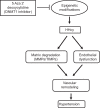Epigenetic regulation of aortic remodeling in hyperhomocysteinemia
- PMID: 24739303
- PMCID: PMC4101656
- DOI: 10.1096/fj.14-250183
Epigenetic regulation of aortic remodeling in hyperhomocysteinemia
Abstract
Hyperhomocysteinemia (HHcy) is prevalent in patients with hypertension and is an independent risk factor for aortic pathologies. HHcy is known to cause an imbalance between matrix metalloproteinases (MMPs) and tissue inhibitors of metalloproteinases (TIMPs), leading to the accumulation of collagen in the aorta and resulting in stiffness and development of hypertension. Although the exact mechanism of extracellular matrix (ECM) remodeling is unclear, emerging evidence implicates epigenetic regulation involving DNA methylation. Our purpose was to investigate whether 5-aza-2'-deoxycytidine (Aza), a DNA methyltransferase (DNMT1) inhibitor, reduces high blood pressure (BP) by regulating aortic ECM remodeling in HHcy. Wild-type and cystathionine β-synthase (CBS)(+/-) HHcy mice were treated with Aza (0.5 mg/kg body weight). In HHcy mice, Aza treatment normalized the plasma homocysteine (Hcy) level and BP. Thoracic and abdominal aorta ultrasound revealed a reduction in the resistive index and wall-to-lumen ratio. Vascular response to phenylephrine, acetylcholine, and sodium nitroprusside improved after Aza in HHcy mice. Histology showed a marked reduction in collagen deposition in the aorta. Aza treatment decreased the expression of DNMT1, MMP9, TIMP1, and S-adenosyl homocysteine hydrolase (SAHH) and upregulated methylene tetrahydrofolate reductase (MTHFR). We conclude that reduction of DNA methylation by Aza in HHcy reduces adverse aortic remodeling to mitigate hypertension.
Keywords: 5-aza-2′-deoxycytidine; DNA methylation; extracellular matrix.
© FASEB.
Figures











References
-
- Jain D., Fishman E. K., Argani P., Shah A. S., Halushka M. K. (2011) Unexpected sclerosing mediastinitis involving the ascending aorta in the setting of a multifocal fibrosclerotic disorder. Pathol. Res. Pract. 207, 60–62 - PubMed
-
- Puranik R., Chow C. K., Duflou J. A., Kilborn M. J., McGuire M. A. (2005) Sudden death in the young. Heart Rhythm 2, 1277–1282 - PubMed
-
- Nishimura R. A. (2002) Cardiology patient pages: aortic valve disease. Circulation 106, 770–772 - PubMed
-
- Moroz P., Le M. T., Norman P. E. (2007) Homocysteine and abdominal aortic aneurysms. ANZ J. Surg. 77, 329–332 - PubMed
-
- Guthikonda S., Haynes W. G. (2006) Homocysteine: role and implications in atherosclerosis. Curr. Atherosclerosis Rep. 8, 100–106 - PubMed
Publication types
MeSH terms
Substances
Grants and funding
LinkOut - more resources
Full Text Sources
Other Literature Sources
Medical
Molecular Biology Databases
Research Materials
Miscellaneous

